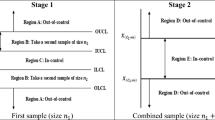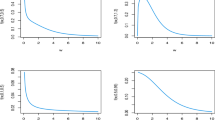Abstract
Queues with general inter-arrival times in batches of random sizes, multi-servers, and finite-buffer spaces are studied, as the determination of their performance measures is a challenging inferential problem. This study focuses on estimating the important performance measures of GIX/M/c/N queues under finite samples. In Kendall notation, this abbreviation represents independent general (GI) distributed inter-arrival times for bulk arrivals of size X, Markovian (M) service times, c identical servers working in parallel, and a maximum number of N users simultaneously allowed in the system, including those under service. Kernel-based methods (constituting a class of well-known nonparametric methods) and classical methods are used to adjust the arrival and service processes. Extensive simulations are performed to verify the quality of the estimations for samples sizes of approximately 500 to provide estimates with a relative error of less than 10%. We also relate notable new insights, for example, that simpler models, such as finite Markovian multi-server queues, M/M/c/N in Kendal notation, are in certain cases sufficiently robust and precise to satisfactorily solve the problem of performance measure determination. The limitations of the results are discussed, and notable topics to be further developed in this research area are presented.









Similar content being viewed by others
References
Abdous B, Kokonendji CC (2009) Consistency and asymptotic normality for discrete associated-kernel estimator. Afr Diaspora J Math 8(2):63–70
Allen AO (1990) Probability statistics and queuing theory with computer science applications. Academic Press, Sand Diego
Almeida MAC, Cruz FRB (2017) A note on Bayesian estimation of traffic intensity in single server Markovian queues. Commun Stat Simul Comput. https://doi.org/10.1080/03610918.2017.1353614
Almeida MAC, Cruz FRB, Oliveira FLP, de Souza G (2017) Bias correction for estimation of performance measures of a Markovian queue. Oper Res. https://doi.org/10.1080/03610918.2017.1353614
Armero C, Bayarri MJ (1994) Bayesian prediction in M/M/1 queues. Queueing Syst 15:401–417
Asanjarani A, Nazarathy Y, Pollett PK (2017) Parameter and state estimation in queues and related stochastic models: a bibliography. http://www.maths.uq.edu.au/~pkp/papers/Qest/Qest.html. Accessed 05 Aug 2017
Bareche A, Aïssani D (2014) Interest of boundary kernel density techniques in evaluating an approximation error of queueing systems characteristics. Int J Math Math Sci. Article ID 871357
Benes VE (1957) A sufficient set of statistics for a simple telephone exchange model. Bell Syst Tech J 36(4):939–964
Blas B, Bolfarine H, Lachos VH (2016) Heavy tailed calibration model with Berkson measurement errors for replicated data. Chemometr Intell Lab Syst 156:21–35
Chiu ST (1991) Bandwidth selection for kernel density estimation. Ann Stat 33:1883–1905
Chowdhury S, Mukherjee SP (2013) Estimation of traffic intensity based on queue length in a single M/M/1 queue. Commun Stat Theory Methods 42(13):2376–2390
Clarke AB (1957) Maximum likelihood estimates in a simple queue. Ann Math Stat 28:1036–1040
Cruz FRB, Quinino RC, Ho LL (2017) Bayesian estimation of traffic intensity based on queue length in a multi-server M/M/s queue. Commun Stat Simul Comput 46(9):7319–7331
Cruz FRB, Almeida MAC, D’Angelo MFSV, van Woensel T (2018a) Traffic Intensity estimation in finite markovian queueing systems. Math Prob Eng. https://doi.org/10.1155/2018/3018758
Cruz FRB, Duarte AR, Souza GL (2018b) Multi-objective performance improvements of general finite single-server queueing networks. J Heuristics 24(5):757–781
Gontijo GM, Atuncar GS, Cruz FRB, Kerbache L (2011) Performance evaluation and dimensioning of GIX/M/c/N systems through kernel estimation. Math Prob Eng. https://doi.org/10.1155/2011/348262
Gross D, Shortle JF, Thompson JM, Harris CM (2009) Fundamentals of queueing theory. Wiley, New York
Gustafsson J, Hagmann M, Nielsen JP, Scaillet O (2009) Local transformation kernel density estimation of loss distributions. J Bus Econ Stat 27:161–175
Kendall DG (1953) Stochastic processes occurring in the theory of queues and their analysis by the method of imbedded Markov chains. Ann Math Stat 24:338–354
Kokonendji CC, Senga Kiessé T (2011) Discrete associated kernels method and extensions. Stat Methodol 8(6):497–516
Kokonendji CC, Varron D (2016) Performance of the discrete associated kernel estimator through the total variation distance. Stat Probab Lett 110:225–235
Lima MS, Atuncar GS (2011) A Bayesian method to estimate the optimal bandwidth for multivariate kernel estimator. J Nonparametric Stat 23:137–148
Little JDC (1961) A proof for the queuing formula: L = λW. Oper Res 9:383–387
Malec P, Schienle M (2014) Nonparametric kernel density estimation near the boundary. Comput Stat Data Anal 72:57–76
Pearson K (1934) Tables of the incomplete Beta function. University College, Biometriks Office, London
Quinino RC, Cruz FRB (2017) Bayesian sample sizes in an M/M/1 queueing system. Int J Adv Manuf Technol 88(1):995–1002
R Core Team (2017) R: A Language and Environment for Statistical Computing, R Foundation for Statistical Computing, Vienna, Austria. http://www.r-project.org/. Accessed 19 June 2017
Silverman BW (1986) Density estimation for statistics and data analysis. Monographs on statistics and applied probability, Chapman and Hall
Vijaya Laxmi P, Gupta UC (2000) Analysis of finite-buffer multi-server queues with group arrivals: GIX/M/c/N. Queueing Syst 36:125–140
Wand MP, Jones MC (1995) Kernel smoothing. Chapman and Hall/CRC; Boca Raton, FL
Zhang S, Karunamuni RJ, Jones MC (1999) An improved estimator of density function at the boundary. J Am Stat Assoc 94:1231–1241
Author information
Authors and Affiliations
Corresponding author
Rights and permissions
About this article
Cite this article
Cruz, F.R.B., Santos, M.A.C., Oliveira, F.L.P. et al. Estimation in a general bulk-arrival Markovian multi-server finite queue. Oper Res Int J 21, 73–89 (2021). https://doi.org/10.1007/s12351-018-0433-y
Received:
Revised:
Accepted:
Published:
Issue Date:
DOI: https://doi.org/10.1007/s12351-018-0433-y




